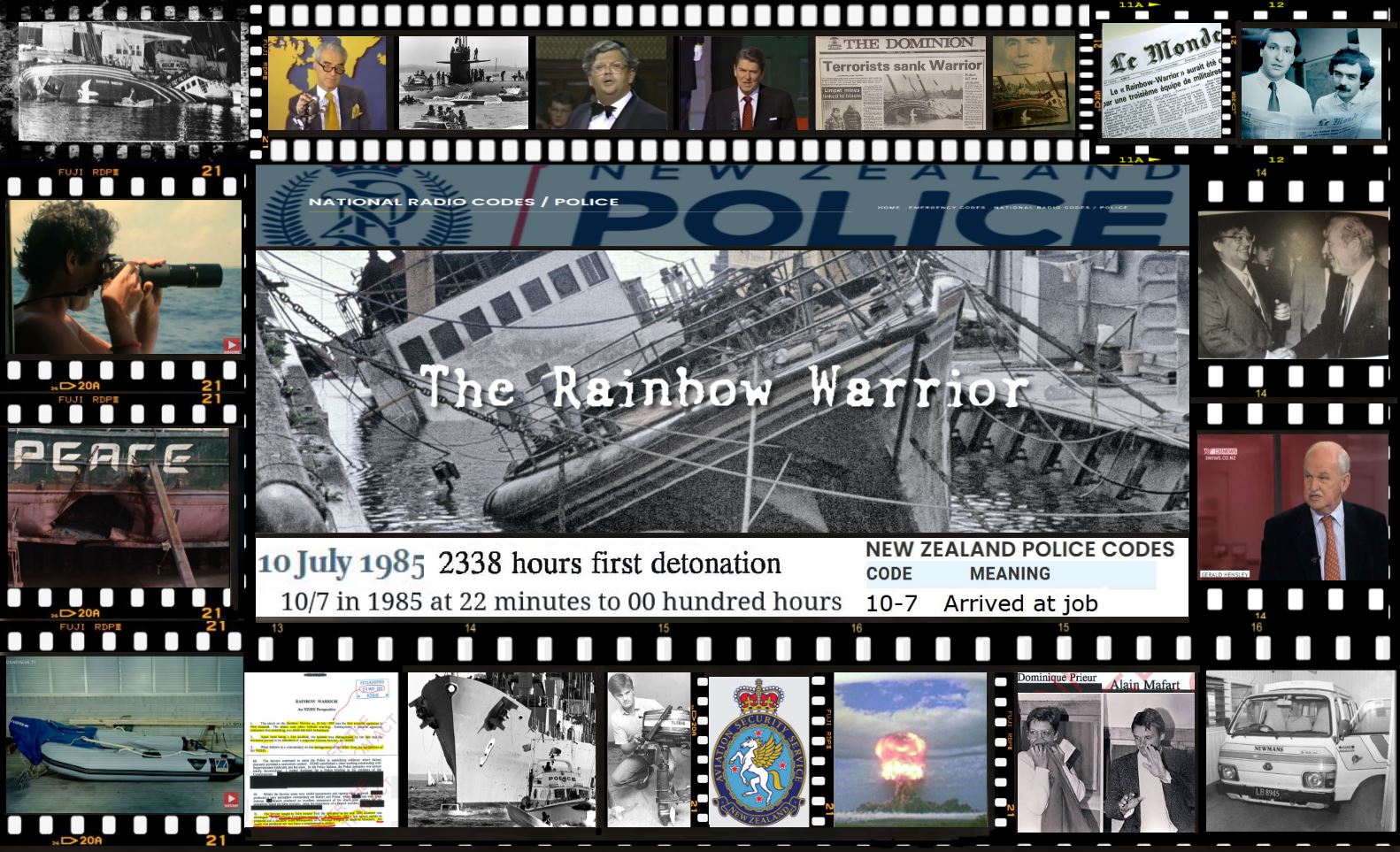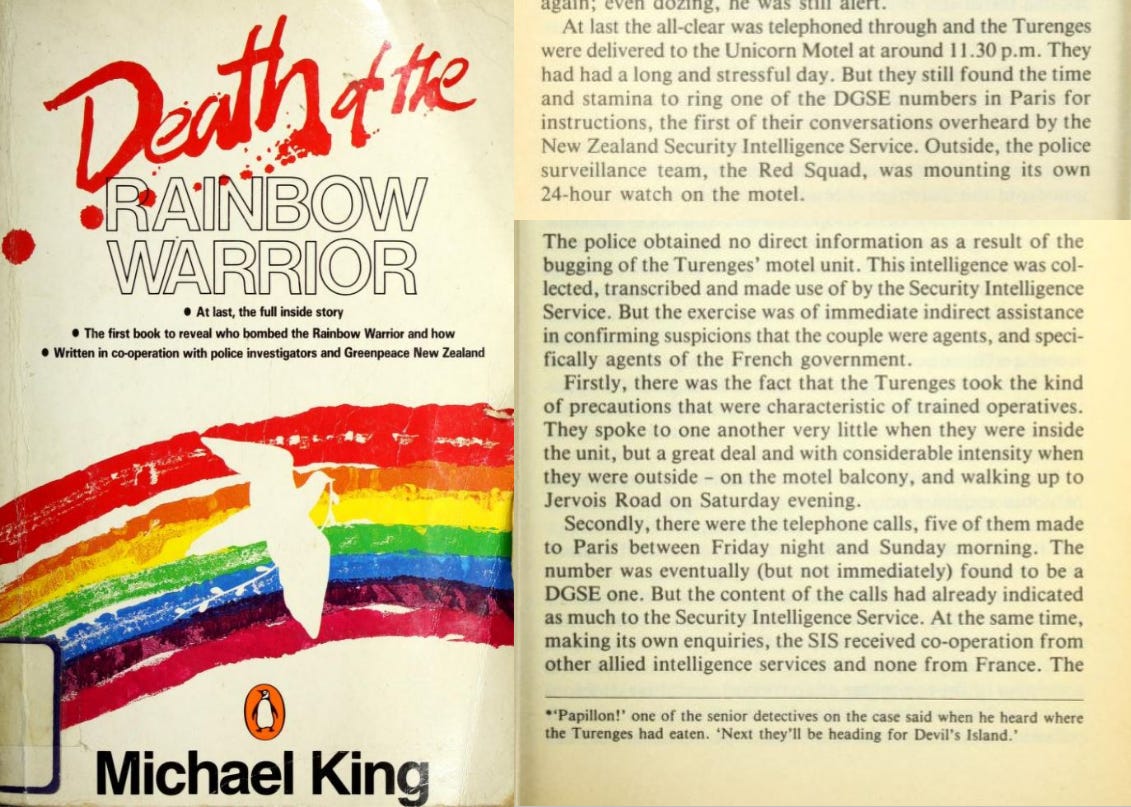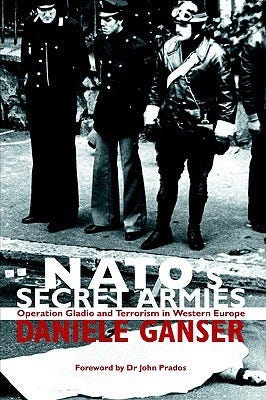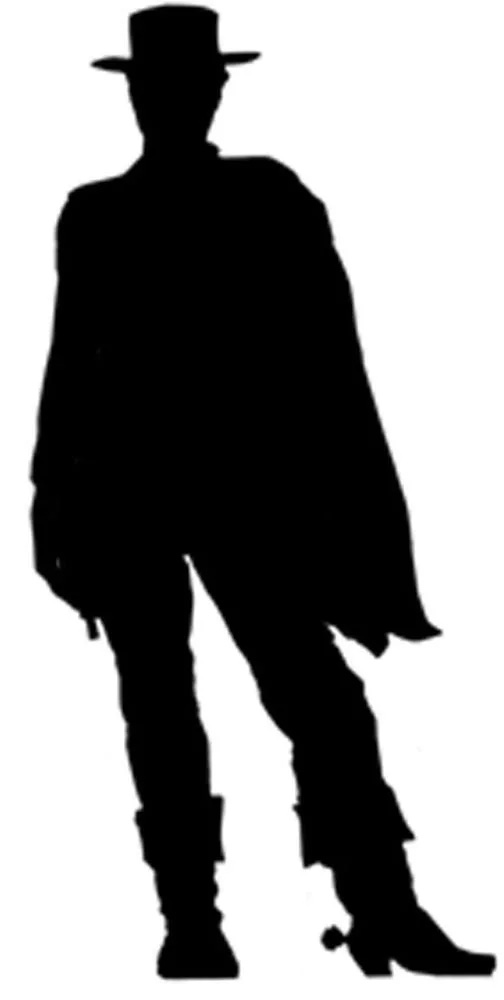The Rainbow Warrior Bomb Plot and the Mystery of the Three-Hour Timer Delay
The bomb plot to sink Greenpeace’s Pacific Ocean flagship, Rainbow Warrior, on July 10 1985 in Auckland’s Waitemata Harbour, New Zealand, appears to have been a metaphor-laden mission designed to engineer a crisis, that would pull New Zealand’s national security state into the ‘club’ on an inside track.
Former Auckland Star paper-boy, Steve Snoopman finds Opération Sataniqué appeared to be designed as an inverted Hansel and Gretel ‘show me how’ lesson that went awry and became a tragic-comic opera featuring a fuming fat man.
The ‘Morse Code’ embedded in the Rainbow Warrior attack communicated to Western élites a sinister directive to get their domestic grassroots movements — including anti-nuclear activists — under control.
The date, 10/7, was potent.
➼ 10/7 — New Zealand Not Immune to Terrorism
The three hour delay set on the timing devices used to trigger the explosions on two limpet mines — that sank the Greenpeace’s Rainbow Warrior, shortly before midnight on July 10 1985 — appears to have been ordered to send a symbolic signal. The date of 10/7 corresponds to New Zealand Police national radio code for ‘Unit Arrived at Job’.*
Internationally, the 10-7 code means ‘Out of Service’ and is called in when an officer goes off duty.
Like all big criminal plots, not everything went according to plan. Covers were blown.
Indeed, the bombing is usually considered to have been a failed mission in state-sponsored sabotage or terrorism — because French state politicians, officials and agents were proven to be the culprits. But, ‘calling cards’ left an enduring legacy.
The two plastic explosive bombs were set with a three hour delay, instead of the usual 24-hour or 48-hour delay afforded to agents to give them time to skip the country.
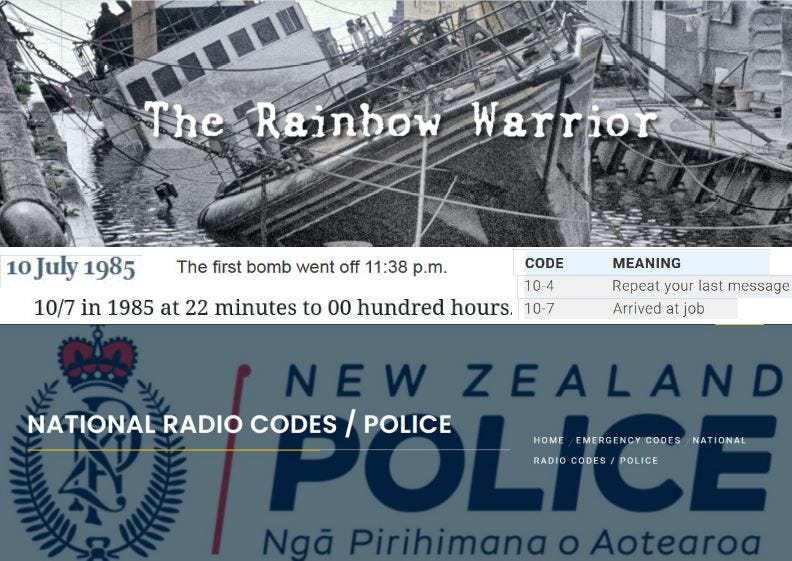
The 1985 bombing mission to sink Greenpeace’s Pacific Ocean flagship at Marsden Wharf in Auckland’s Waitemata Harbour quickly went awry for France’s secret service agents, due to this shortened countdown. While the bombs ticked, errors occurred.
Agents of France’s equivalent to the CIA — La Direction Générale de la Sécurité Extérieure (DGSE) — were ordered by French Defense Minister, Charles Hernu, to set the timers with a three hour countdown to detonation. This short delay had consequences.
In 2015, French DGSE diver, Colonel Jean-Luc Kister, who set the two limpet mines, said the reason for the shortened bomb countdown still perplexed him.

DGSE agent Major Alain Mafart — who was second-in-command of the DGSE’s underwater combat school in Corsica in the early 1980s, and who had also trained with a British commando unit, the Special Boat Service — also did not know why the timer delay was so short. The Rainbow Warrior was due to leave port on July 23, or not for another 13 days.
The shortened timer countdown was the primary factor that led to Major Mafart and his fake wife, Captain Dominique Prieur, being detained by New Zealand Police two days later.
Before dawn of 11 July, Royal New Zealand Navy divers discovered the ship’s hull was blasted inward from outside the engine room. It couldn’t have been an angry whale.
On Friday July 12, the capital city’s morning newspaper, the Dominion Post reported Police Commissioner Ken Thompson said New Zealand was not immune to terrorism.
The Government of François Mitterrand appear to have sent ‘signals intelligence’.
State-sponsored terrorism had arrived in New Zealand, on a codified date: 10/7.

Although it is integral to covert operations that their nature is secret and to hide the identity of the perpetrators, they have characteristics that allow them to be identified.
Covert actions are conducted or promoted secretly with the intention to influence an environment whether politically, militarily, economically or culturally, such that eventual public knowledge of such events cannot be attributed to the actual country, or organization responsible, or its design allows for plausible deniability.
This implies that intelligence agencies can identify such features.
The ‘Morse Code’ embedded in the Rainbow Warrior Bombing signalled there was a price to pay for allowing activist groups to become so defiant and influential, that they had a Prime Minister, David Lange, who actively encouraged the nuclear-free cause.
A theatrical quality underscored three political conflicts: the U.S. nuclear powered and armed warships, the ANZUS military alliance, and nuclear tests in the Pacific — that all converged with the bombing of Greenpeace’s Rainbow Warrior Pacific flagship.
It seems Opération Sataniqué, the mission’s code-name, was intended to unexpectedly resolve a deadlocked conflict, with a contrived solution to a problem that relied on an agent external to the situation, jolts the narrative’s internal logic, and challenges suspension of disbelief — without breaking that suspension for naïve audiences.

A brutal intervention was pursued as a warning signal to the Western Alliance nations to re-assert control over their domestic activists. Four Western Alliance countries — France, the Netherlands, Norway and Italy — as well as Japan and Singapore, worried that if there was not a cost inflicted on New Zealand, anti-nuclear activists elsewhere would be emboldened and their defiance might snowball into widespread rebellion, near the Cold War’s end. The symbolism was deciphered. Lange sensed as much.
France viewed a planned flotilla to protest the upcoming French nuclear bombs tests at Mururoa Atoll as a threat. The Rainbow Warrior was to be a flotilla ‘mothership’, and with a recent refit — complete with sails, and radio broadcast equipment that could transmit photographs — the 130-ft converted cod trawler could be at sea for months.
The issues that the French state had with the impending flotilla — and the publicity it would draw — were a challenge, but secondary to the needs of the Atlantic Alliance.
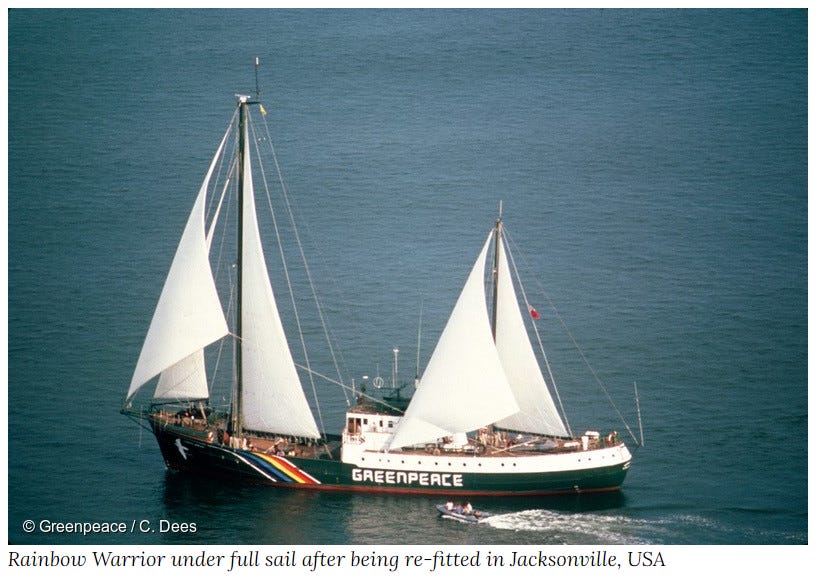
Likely, France intended a big death toll, too. Amazingly there was only one fatality.
In this curious case of the half-sunk seahorse, the DGSE agents involved in the operation later claimed they intended to mitigate deaths, by setting two bombs to go off four minutes apart. And that the first bomb was a warning there would be a second.
However, the first bomb — which blew a large hole in the hull where the engine room was located and caused the ship’s lower decks to rapidly fill with seawater — occurred with no warning. The first limpet mine was also the largest. No one expected a second.

Rainbow Warrior photographer, Fernando Pereira, drowned while retrieving his cameras when he became trapped in his room below a collapsed stairwell after a second magnetic limpet mine — placed on the propeller turbine shaft — exploded. Pereira’s body was found at 4am, 11 July, by Royal New Zealand Navy divers.
The bombing was also timed to occur on the night of 10/7 during the birthday party of Greenpeace Director, Steve Sawyer. It would appear Operation Commander Lt. Col. Louis Dillais — and perhaps others with higher pay-grades — wanted the Greenpeace director to die with his guests. There’s a crass saying in news: ‘if it bleeds, it leads’.

Fortunately, by 11.30pm, Steve Sawyer had moved the party to the Piha Surf Club, since the frontier coastal community was where some members of Kiwi pop band, Split Enz, would retreat to when staying in Auckland. Two members of Split Enz were invited and narrowly missed being aboard the Rainbow Warrior that fateful evening.
Skipper Peter Willcox said if the first bomb had exploded a half hour sooner, the Peace Fleet Flotilla planned for Moruroa Atoll would have lost 20 people because the birthday party and the meeting in the cargo hold had just finished.
At the time of the first detonation, New Zealand Herald news editor Bert Nealon was climbing the stairs back to newsroom as the first edition for the following morning had just gone to print. He felt the shock-wave of the first explosion hit the building at 11.38 p.m., which was a few blocks away from the wharves. The Herald phoned emergency services before the second blast. The newspaper stopped the press.
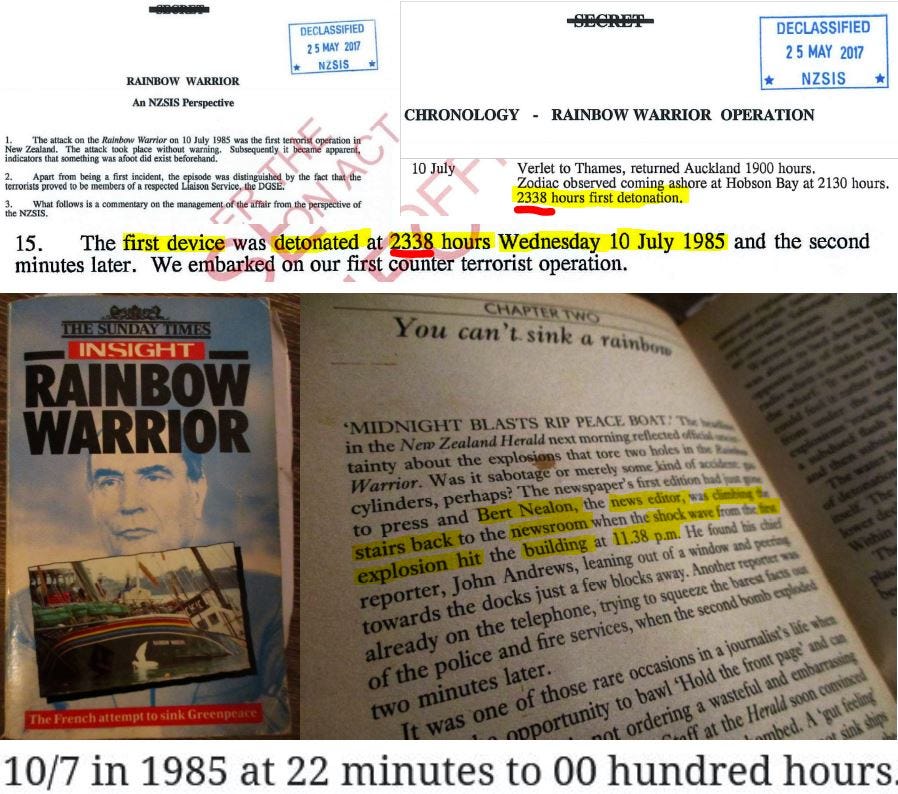
The first police unit arrived at a job in the last minutes of 10/7 to figure out what caused Greenpeace’s Pacific flagship to become a picture of a half-sunk seahorse — and how the ship was rendered ‘out of service’.
➼ ‘Orgie of Evidence’ — Call Signs from the Zodiac Constellation, Pegasus
Nine weeks after the bombing, France’s Prime Minister Fabius Laurent admitted the “truth is cruel”. A DGSE source told the Washington Post, “They left a trail so Gallic that the only missing clues were a baguette, a black beret and a bottle of Beaujolais”.
Early in the NZ Police investigation, code-named ‘Operation Wharf’, Chief Inspector Allan Galbraith’s detectives thought the trail of clues was a frame-up job, since so many cast a finger of blame at France. Prima facie data reveals symbolism.
The orgie of evidence led to the unplanned capture of two agents — amid the Cohen Brothers-esque post-bombing drama of get-a-way errors, confusion and panic.

In 2005, head of the DGSE’s Counter-Terrorism Intelligence and Operations Co-ordination Unit, Alain Chouet scorned Mafart’s take, referring to the Hansel and Gretel fairytale:
“The operation was put together by amateurs, who trailed clues behind them like Hansel dropped stones behind him.”
— Alain Chouet, Head of the DGSE’s Counter-Terrorism Intelligence and Operations Co-ordination Unit
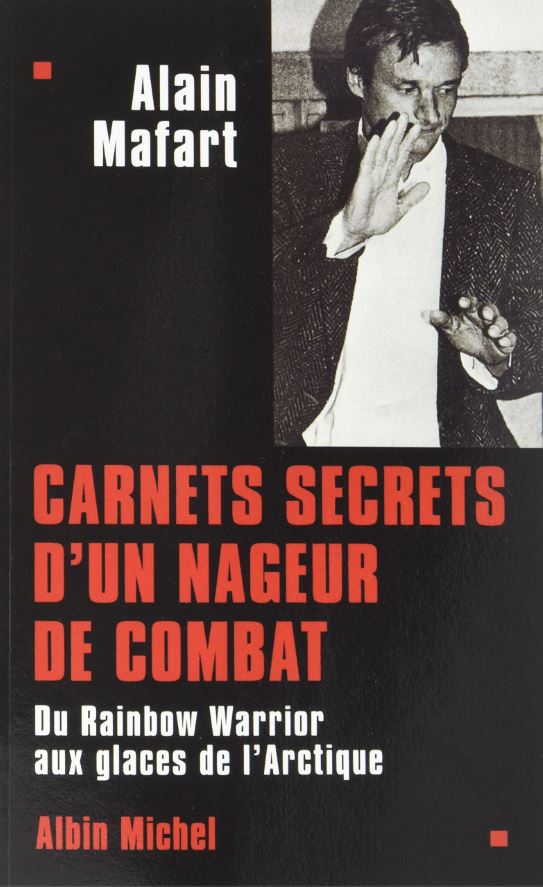
The people responsible for drawing up the blueprint and orchestrating the planning for the mission — was Colonel Jean-Claude Lesquer, the head of DGSE’s Action Service, which specializes in covert operations — and the Defense Minister’s Cabinet, reported French newspaper Libération journalist, Jean Guisnel. According to DGSE chief, Admiral Pierre Lacoste, he personally gained President Mitterrand’s authorization in Elysée Palace, on May 15, for the neutralization project: ‘Opération Sataniqué’.
Col. Lesquer et al appeared to have concocted a plot as an inverted ‘Hansel and Gretel’ tale — complete with a metaphorical ‘cooking demonstration’ — as ranks closed to signal defiance was the enemy of the Alliance: anti-nuclear peaceniks.
New Zealand and Greenpeace were targets.
The planning was rushed. The DGSE had no back-up plan if the mission went awry.
One French-speaking man had been observed making an ill-timed rendevous with the camper-van at the shore of Mechanics Bay next to the boat-sheds, not far from the Ports of Auckland wharves. Major Alain Mafart, who was driving the camper-van, had missed picking up Zodiac pilot, Gérard Royal, who had difficulty finding his way back in the dark, and was hampered by the low-tide. Boaties noted the camper’s rego.
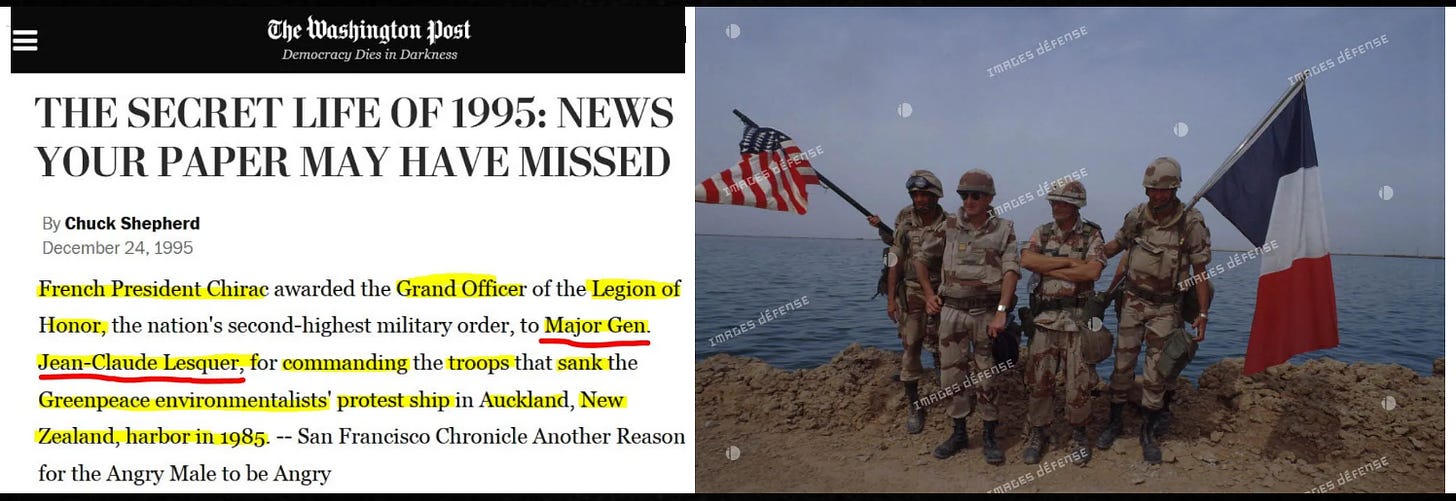
Newmans office clerk, Rebecca Hayter, stalled the fake Swiss married couple, Major Alain Mafart and Captain Dominique Prieur, who posed as ‘Alain and Sophie Turenge’ when they returned the rented campervan early. Inadvertently, Hayter stole the role of Gretel. The police would soon arrive and help her shove the wizard’s accomplices into a French-manufactured oven. Col. Lesquer seems to have cast himself as a wizard practicing symbol sorcery.

The camper-van’s corporate logo featured a Greek mythical flying horse logo, the Pegasus symbol, a mythical winged divine horse from Greek mythology that celestial cartographers portray as half of a horse, rising out of the ocean. The Greek God, Zeus, is said to have transformed Pegasus into the constellation visible in the northern and southern sky, with the brightest star being an orange super-giant, Epsilon Pegasi.
On July 8, forestry workers noticed a Commodore carrying a Yamaha outboard motor and an un-inflated Zodiac, and noted its license number, LR 8114, on their dusty work vehicle. This Commodore was hired by Ouvéa yacht captain, Roland Verge.
The Ouvéa, was a 12-metre yacht, chartered from Noumea that delivered the Zodiac, Yamaha motor and bombs to the New Zealand support crew, Alain Mafart and Dominique Prieur. The Ouvéa crew, Chief Petty Officer Roland Verge (alias Raymond Velche), Petty Officer Gerald Andries (alias Eric Audrenc), Petty Officer Jean Michel Bartelo (alias Jean-Michel Berthelot), and Doctor Xavier Maniguet — pretended to be French tourist divers. Team Ouvéa may have been on standby as back-up crew on the night of the operation. Dr Maniguet was a specialist in treating diving accidents, while the others had trained in Corsica.
Narratively, the dive team rode on a Zodiac, set the big bomb on the starboard hull and the Rainbow Warrior became a seahorse sinking into the ocean. Then a van bearing the Pegasus logo picked up the Zodiac pilot. The bomb team drove to the capital in a Horizon campervan, and crossed the horizon on a ferry to the South Island to lay low.
Meanwhile, the trail of clues led police to the Commodore hired by the skipper of a sloop, but they slipped out of a neighbouring British Commonwealth jurisdiction.

The mission’s curious code-name — Opération Sataniqué — even suggests, the devilish planners packaged other elemental parts with ironic weaponized metaphors.
Prior to the bombing, on July 9th, Mafart and Prieur transferred the explosives, diving equipment and the Zodiac to the French attack team who were staying at Hinemoa Motel, in Parakai 50km north-west of Auckland CDB. The motel, which was located at the site of a hot springs that attracted tourists, took its name after the Māori legend of Hinemoa. The transfer of the Zodiac at this location was potent on several levels.
In this tale of ‘star-crossed lovers’, the high-born Hinemoa fell in love with Tutanekai, who lived on Mokoia Island, Lake Rotorua. Her people, suspecting something was afoot hid all of the canoes, and so — using gourds as floats — Hinemoa swam across Lake Rotorua, following the music played by Tutanekai. Hinemoa warmed herself in the hot-pool on Mokoia Island, where Tutanekai’s servant brought a gourd to fill with water. She spoke in a gruff voice to feign being a man and when she learnt of his errand, she asked to drink from the gourd and then smashed it. Eventually, Tutanekai discovered her bathing, because she broke every gourd each time the servant returned. Ergo, Hinemoa’s calling card was the broken gourds. Naturally, Tutanekai was excited to see the rude man was actually his nude love interest.
She got his attention. They bred.
Intriguingly, the Hinemoa Motel was part-owned by New Zealand’s Prime Minister, David Lange, as an investment property. The subtext of this ‘coincidence’ signalled, it would appear, that Mr Lange would have to be ‘accommodating’ of the fact that the French DGSE agents had stayed in the unit he owned three times, since he would find no allies would rebuke the French Government for the attack. In his 1986 special report, TVNZ news anchor Dougall Stevenson said the happenstance of the ‘Turenges’ staying at Lange’s motel unit was either “coincidence, or the height of arrogance”. Ironically, the report The Rainbow Warrior Affair, featured a cheesy synthesizer rendition of Europe’s 1986 pop song, “The Final Countdown”.
The DGSE appears to have left a calling card and Lange seems to have been sent a threat.
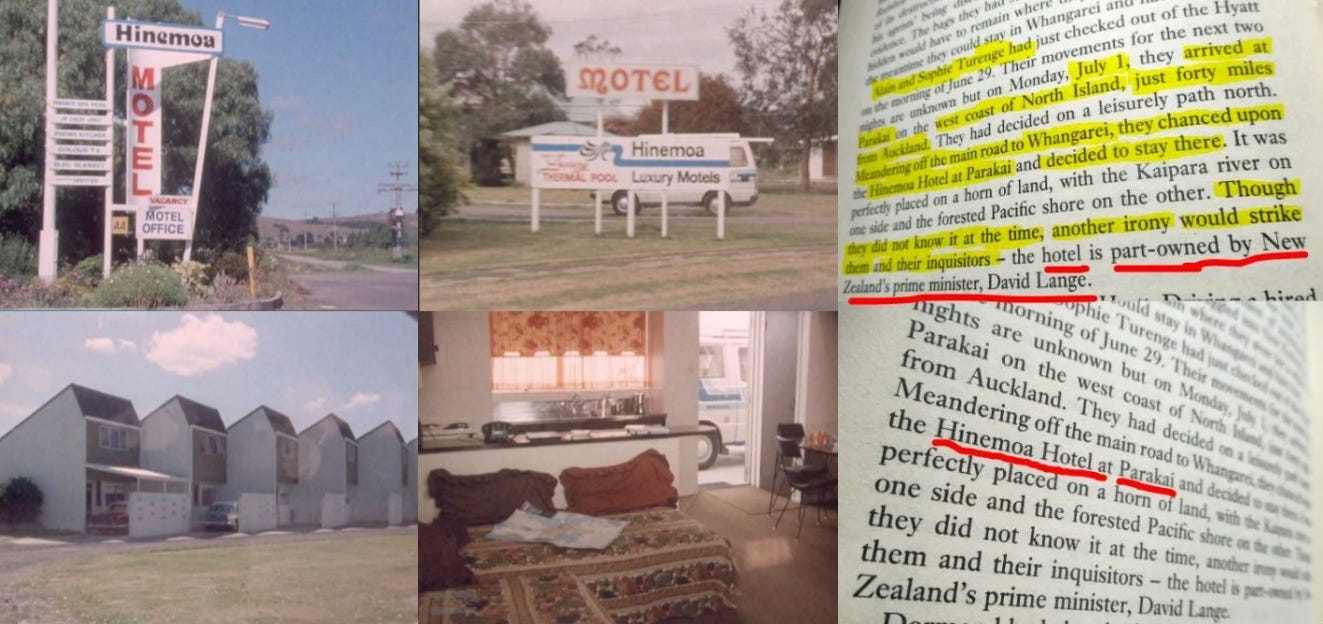
In spite of the PM’s assurance that no effort would be spared, the Beehive Officials Terrorism Committee, was very accommodating of the need to limit fallout with France.
Once the French Connection to the Rainbow Warrior Bombing was proven, Lange had noticed that neither the Ronald Reagan, nor Margaret Thatcher or even Bob Hawke, would condemn the attack. The two Western nuclear powers, and New Zealand’s uranium producing Tasman neighbour, appeared to have radioactive skin in the game.
Indeed, the morning after Lange’s 1984 election, the U.S. Secretary of State, George Schultz flew into Ohakea Air Force Base to discuss the ANZUS military alliance with him. The Prime Minister-elect evidently told Mr Schultz that he needed six months to resolve the issues to everyone’s satisfaction. Schultz told journalist Richard Harman 10 years later on TVNZ’s current affairs program, Frontline, Five Days in July, that he reported to President Reagan his conversation with Lange. Schulz added:
“We gave time. We didn’t precipitate anything. And we were ready to, try to make an accommodation as we did with other countries.”
— Richard Harman Frontline, Five Days in July, TVNZ 1996

In a TVNZ documentary, Death of the Rainbow Warrior, news anchor Dougall Stevenson observed the lack of condemnation following the sinking of the Greenpeace ship. Lange told TVNZ there was a solidarity between the big powers, who wielded a nuclear deterrent capacity, and those big powers perceived they had no need to be supportive of a small power principle. Therefore, the French were well aware that the Reagan’s Administration’s ‘accommodation’ of Lange’s domestic situation was wearing thin.
Thus, I contend France was not the only nuclear power that had ran out of patience and had decided that it was time for David Lange to accommodate the French DGSE.
Ergo, a motel whose name riffed off the legend of the tale of ‘star-crossed lovers’, was used as the location to deliver the Zodiac, limpet mines, and diving equipment to the dive team, by the support team driving a campervan featuring the Pegasus symbol.
The two French DGSE agents made phone calls, with cover of telephoning a sick Uncle Emile, while they were detained by New Zealand Police at the Unicorn Motel in Auckland in mid-July to their headquarters in Paris. This error revealed the hubris of rushing the Sataniqué mission. New Zealand’s Security Intelligence Service bugged the room where the two agents — who posed as Swiss honeymooners ‘Alain and Sophie Turenge’ — while the Police played for time to determine if the passports they used were fake, and therefore could be formally arrested while more evidence could be gained to pin them to the sinking of Greenpeace’s Pacific flagship. Years later, Captain Prieur said on French TV that she was dumbfounded when Police told her the calls were traced to the DGSE because she thought the number was secure.
But, because two French secret service agents were caught, the intrigue deepened to reveal the exquisite self-binding dynamic that occurs when key players double-down.
The chairman of New Zealand’s Intelligence Council, Gerald Hensley, who also just happened to be the Chairman of the Officials Terrorism Committee, was also head of the Prime Minister’s Office at the time of Rainbow Warrior conspiracy.
In his 2013 book, Friendly Fire: Nuclear Politics and the Collapse of Anzus, 1984-1987, Hensley neglected to mention that the Officials Terrorism Committee that he chaired constrained the investigations into the Rainbow Warrior Bombing as damage control to limit fall-out with the Western Alliance. The SIS’s sanitized and moderately redacted 1996 report, entitled Rainbow Warrior – An SIS Perspective, was declassified in 2017.

Disturbingly, the secret 1996 report authored by a New Zealand Security Intelligence Service (SIS) executive, stated that as the intrigue unravelled an attitude to limit the scope of the investigation developed once Mafart and Prieur were in custody.
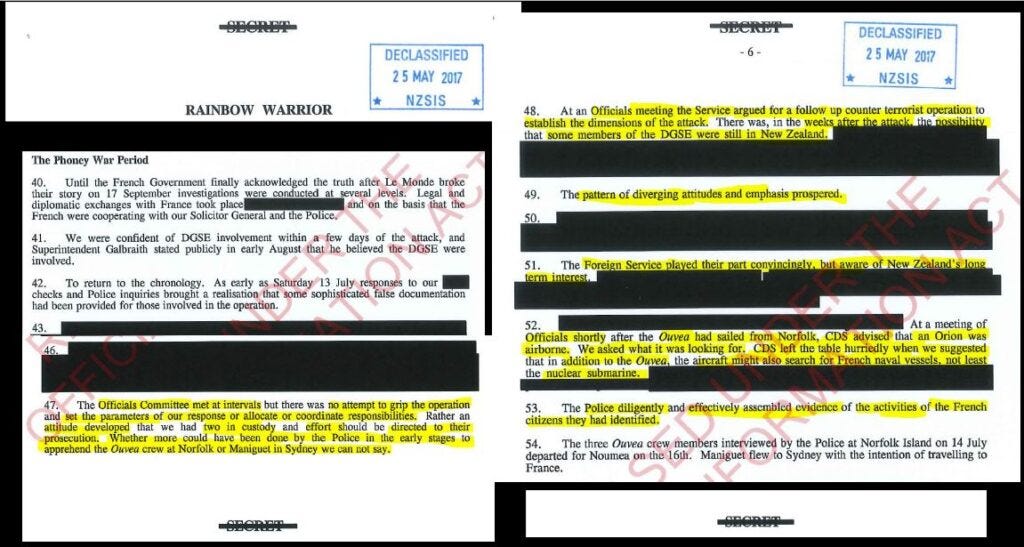
The SIS executive, who represented the NZ Security Intelligence Service at the meetings, said the Officials Terrorism Committee decided to merely seek their prosecution, rather than coordinate efforts to uncover the dimensions of the attack, to catch other DGSE agents in New Zealand, as well as probe the extent of the French state’s involvement. Due to this constriction over the investigation, the DGSE dive team, comprising Colonel Kister, Jean Cammas, Gérard Royal and Operation Commander Lt. Col. Louis Pierre Dillais were able to lay low in the South Island.
Suspiciously, it took months to ‘discover’ that the DGSE dive team had crossed the Cook Strait on 11 July 1985, despite their aliases appearing on the Cook Strait Ferry passenger manifest. Ergo, the French DGSE bomb team were to drive to the capital, Wellington, in a Horizon campervan — amid the country’s biggest ever ‘manhunt’ — and skip over the horizon on the state-owned ferry service, right under the bloodied noses of the national security state’s HQ’s.

Then, on July 26th the bomb team flew to and out of Auckland, three days after Lt. Col. Dillais.
Curiously, NZ’s Aviation Security Service, applied to Buckingham Palace in 1993 to have the mythical Pegasus as its insignia, gushing the mythological flying horse is surrounded by the blue waters of the Pacific and the stars of the Southern Cross, without any blushing emojis. AVSEC’s 40th anniversary brag neglected to mention its fail in the mid-1980s to catch any French speaking ‘tourists’, despite the DGSE screwing up all the practicalities of the French subversion nouns that permeate into English usage, such as: incognito, reconnaissance, espionage, subterfuge, rendezvous, sabotage and terrorist.

Indeed, AVSEC failed — along with NZ’s SIS and Police — to catch the bomb team skiing at Mt Hutt and Lt. Col. Dillais, who went white-water rafting on the Shotover River jet-boat tours, near Queenstown.
A royal time was had. After all, diving south the tropics was hardly a winter sport. The private jokes continued.
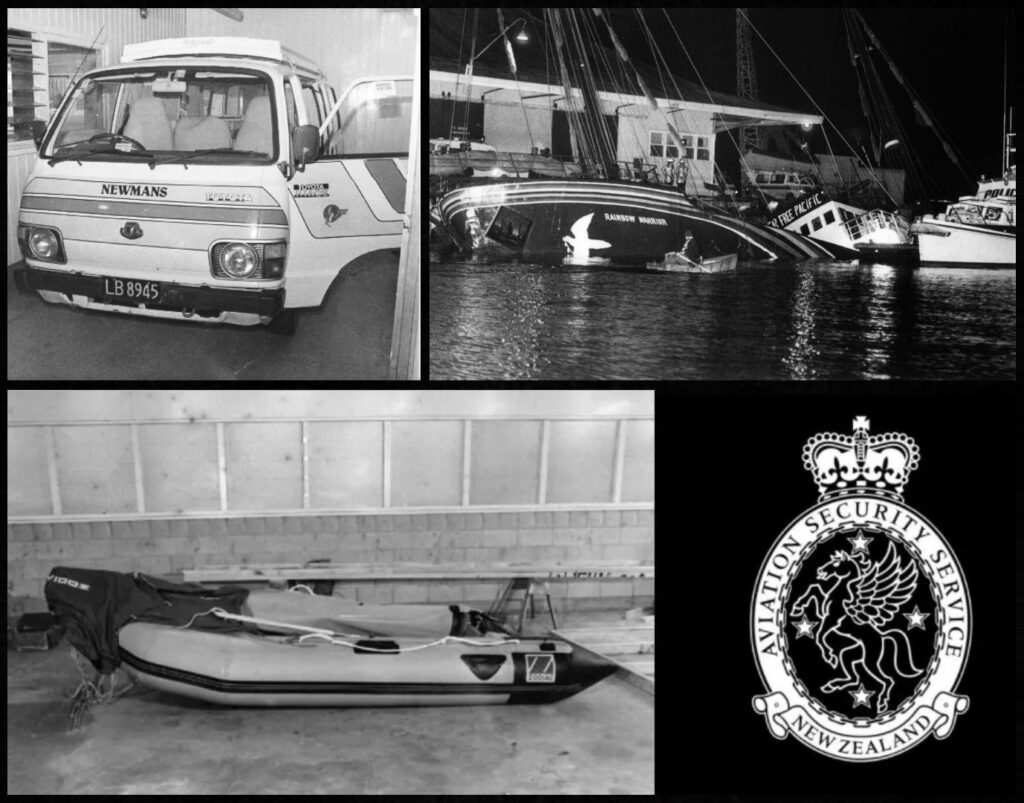
The French-manufactured Zodiac inflatable dinghy and Japanese-made Yamaha outboard motor were purchased on May 29th 1985 at Barnet Marine Centre in Greenhill Parade in North London by DGSE agent Petty Officer Gerald Andries. He couldn’t speak English. This was not merely a clumsy attempt to avoid the French link to the terrorist plot by making it seem like Andries was a tourist buying an inflatable while on holiday in England — as Le Monde and The New York Times reported on September 17th and 18th 1985. The Zodiac and Yamaha purchases were ‘signals intelligence’.

Both companies reinvented themselves after World War II. Zodiac Aerospace was a French aerospace group founded in 1896, that supplied systems and equipment for aircraft. The company benefited from the boom in airplanes and airships during both world wars, and afterward, the boom in leisure activities, especially the French infatuation with recreational boating. During World War II, Yamaha had been repurposed for war-time manufacturing. In 1955, Yamaha Motor Company was spun off from Yamaha Corporation, which is a Japanese musical instrument and audio equipment manufacturer that was established in 1887 as the Nippon Gakki Co. Ltd.

Ergo, while New Zealand was in the midst of re-inventing itself as a model corporate-state, both France and Japan worried that their rebellious anti-nuclear activists would be emboldened unless they saw New Zealand’s activists pay a stiff price. The defiant South Pacific archipelago needed to suck up the Alliance’s nuclear terror. After this Cold War-era mission, the bomb team would enjoy the South Island’s leisure sports.
The DGSE has a specialist economic intelligence section. Lange’s Government were in the midst of inflicting blitzkrieg corporate heist of the economy — without an electoral mandate. They were compromised.
The DGSE agent, Andries, was leaving a call-sign to his intelligence counterparts at MI5 that some ‘friendly fire’ between allied nations was being foreshadowed. The French ‘celestial astrologers’ were leaving a ‘horoscope’ for the spooks at British MI5 to consult with their ‘celestial cartographers unit’, to decode the mission objective.
MI5, which is Britain’s equivalent to the FBI, were evidently told the French DGSE were planning a sting because New Zealand was allegedly a trans-shipment point for a gun-running ring to Melanesians in French New Caledonia seeking independence.
This was a cover-story so flimsy, a newspaper horoscope columnist could have deciphered its meaning. After all, Andries had trained in Corsica. While there was an independence movement, and guns were being supplied, and New Zealand had been used as a trans-shipment point — the idea of a Western Alliance power pulling off a sting within a Five Eyes country indicated one thing: cryptic subtext.
If it took a long time to hear of this scene, such an audience was, in effect, in an ensemble cast of bitpart players, or extras, in a politically ‘deaf community’.
Lange, and his Cabinet, had been consigned to this politically ‘deaf community’.

If the SIS is to believed, it learned of the bomb plot the same way as Radio Active.
MI5 had also observed the arrival of the fake Swiss tourist couple in London en route to New Zealand. In the Northern spring of 1985, word was leaked to a Western agent in Paris that a French plot would play out in New Zealand.
This information was brought to the attention of intelligence officials at a weekly meeting at Whitehall in London in May. This gathering of the Joint Intelligence Committee, which usually occurred on a Wednesday, between Australia, Canada, New Zealand, the United States, and the United Kingdom — including Britain’s MI5 and MI6 — was the result of an alliance formed in 1947. New Zealand was brought into the spooks club in 1956, as the fifth Anglo-Saxon nation partnering to a treaty known as the UKUSA Agreement.

Under this secret decree, each nations’ security service pledged to share intelligence information among themselves. In The Rainbow Warrior Affair, Richard Shears and Isobelle Gidley wrote that the information received by New Zealand intelligence officials was not specific, and may have been understood as an intelligence operation.
Crucially, the Government Communications Security Bureau (GCSB) did not provide any intelligence warning of an impending French attack or suspicious operation occurring in New Zealand — as Nicky Hager observed in Secret Power: New Zealand’s Role in the International Spy Network. The lack of ‘warning’ is intriguing. For one thing, the GCSB received weekly minutes from Whitehall’s Joint Intelligence Committee. For another, Hager said there were minutes missing from the GCSB’s intel for 1985.
Intriguingly, in an early 1985 press conference, one U.S. State Department Official emphasized there would be costs in the courses pursued by citizen movements deemed a threat to the Western Alliance. Lange and his Cabinet had rejected a visit of the USS Buchanan to New Zealand, intended to occur after an ANZUS exercise in March 1985, on the grounds the warship was capable of launching nuclear equipped submarine missiles. Lange said the ship’s selection was a set-up by Washington, while he was in Tokelau knowing NZ’s PM wouldn’t agree.
The U.S. Official said:
“Some Western countries have anti-nuclear, and other movements, that seek to diminish defense cooperation among the allied states. We would hope that our response to New Zealand would signal that the course these movements advocate would not be cost free.”
— U.S. State Department Official, in: Great Confrontations at the Oxford Union: “That all Nuclear Weapons are Morally Indefensible”.1985, Harborside Films

Hensley also recalled that Kim Beazeley, Australia’s ambassador to the United States, and Bill Hayden, leader of the Australia Labour Party, also argued that New Zealand’s policy position could not be cost-free. Ironically, elite consensus was against the popular will.
The irony deepens when it is recalled that combat dive team leader, Colonel Jean-Luc Kister, who set the two bombs to the Rainbow Warrior’s hull, revealed on TVNZ Sunday program in 2015 that he was told the justification for the mission was that Greenpeace New Zealand had been infiltrated by the KGB.
In other words, Colonel Kister evidently fell for what would be a cover-story; that the environmental and peace activist organization had been penetrated by totalitarian ‘far-left’ commie spies from Soviet Russia.
TVNZ’s Sunday team didn’t comprehend that Colonel Kister wasn’t merely been told a lie, in order to go along with targeting ‘conservation commandoes’. This proven case of state-sponsored terrorism had a geo-political objective that was integral to Gladio operations’ primary motive; to jolt the target environment to influence its politics. In this case, I contend, it was intended to send shock wave through the Western Alliance that a course correction regarding tolerance of activists was required.
The first bomb blew a nine foot by six foot hole in the hull adjoining the engine room, directly below the noun “peace” in the pronoun, Greenpeace, on the star-board side.
The first explosion, which sent shrapnel flying through floors and walls, caused the ship to fill rapidly with sea water, and sank in about 45 seconds, Willcox said.
Kister and Cammas used a rope tied with knots at regular intervals, that they counted off to measure precisely where to set the first, larger bomb against the hull outside the engine room. Kister would set the second bomb’s timer to detonate four minutes later.
Later, N.Z. Police claimed the SIS knew that French agents were active in the North Island of New Zealand, but that this information was not passed on to Police. In their 1996 report, SIS officials claim they argued to the Officials Terrorism Committee for a counter terrorism operation to establish the dimensions of the bomb plot.
Especially, since there was the possibly that French DGSE agents were laying low in New Zealand — as the drama unfolded. However, in their 1986 book, The Rainbow Warrior Affair, Shears and Gidley reported the SIS were reluctant to help the Police. They stated:
“Even after the attack on the Greenpeace flagship, the NZSIS were reluctant to co-operate wholly with the Aucland police. In the long-term intelligence game, the sabotage was regarded as inconsequential, and not worth destroying relations between the DGSE and the NZSIS.”
— Richard Shears and Isobelle Gidley, The Rainbow Warrior Affair, 1986
Col. Lesquer’s apparent rework of Hansel and Gretel was still playing out in Nouvelle-Zélande.
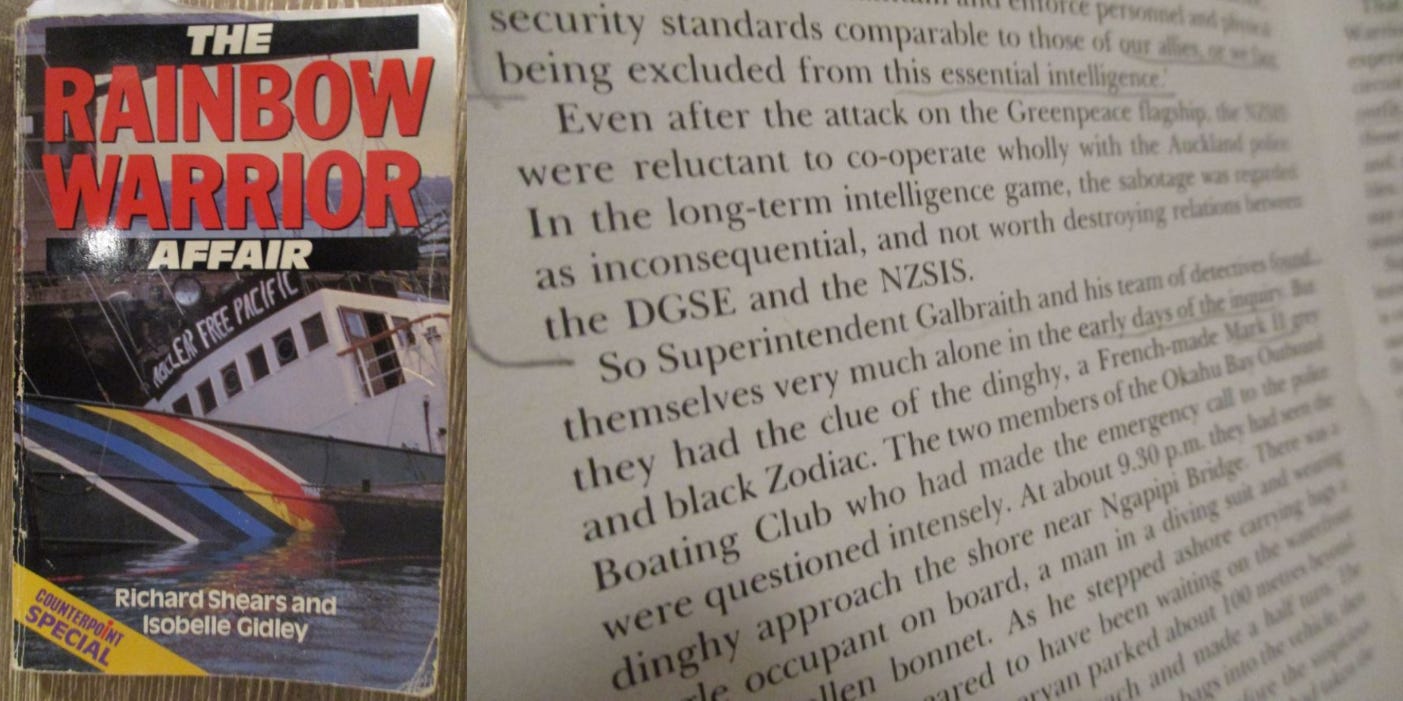
In the ‘secret’ SIS report written ten years after attack on Greenpeace’s flagship, ‘the Service’ seemed to fail to grasp there was prima facie data indicative of encoded symbolism. The apparent codified zeitgeist communicated there was a price to pay for political activism that weakened the military power of the Western Alliance, to those attuned to symbol-laden events.
➼ Theater is the Currency of Terrorism

If we take the adage ‘terrorism is theater’ that was coined by former U.S. Special Operations Officer, Brian Michael Jenkins, while he worked as a Research Analyst in Terrorism at the Rand Corporation in 1973-74, to mean the real targets of terrorism are not the victims, but the audience, who might be the primary target audience of the Rainbow Warrior bomb plot?
Jenkins made this observation while working at the Rand Corporation — a key American think-tank, where game theory strategies were developed during the ‘Cold War’ to stabilize the power structures of the Russia Empire and the Western Empire.
Game theory strategies such as ‘Hostage Exchanges’ are used by nation states, international syndicates and monopolistic cartels to stabilize power structures while aggressive colluding rivals seek to construct new areas of market dominance by illegal, fraudulent and repugnant means that harm their more dynamic, innovative smaller and peaceful competitors, societies or organizations cast as enemies.
In their paper, “Resolving social conflicts through hostage posting: theoretical and empirical considerations,” Gideon Keren and Werner Raub noted that “tacit communications of threats and promises are two major message strategies used to influence the behaviours of others”.
As crisis management expert Paul ’t Hart observed in his 1993 paper, “Symbols, Rituals and Power: The Lost Dimensions of Crisis Management”, ‘crises’ can be contrived and manoeuvred by actors within and external to the state apparatus, and provided they can control the ritualized symbolic actions, they can also constrain the meanings. In an atmosphere of calamity and urgency, those who control perceptions about what caused the crisis and what might resolve it, will tend to gain politically. Therefore, the construction of events under the rubric of a ‘crisis’ “creates a self-binding dynamic,” since the act of characterization is rhetorical and lends itself to semantic descriptions.

France’s story unravelled from one merely of reconnaissance, to claiming the attack was sabotage, rather than a broader political agenda of terrorism. The Lange Administration filtered their complicity in the cover-up.
Since Jenkins made his observation to point out that terrorism is designed to induce shock, fear and submission on the watching audience — and the prima facie evidence presented here indicates a metaphor-laden operation — it would seem the primary target audience were those Western Alliance élites, attuned to decrypting the ‘Morse Code’ embedded in such events. And, especially, NZ’s intelligence echelon.
Pertinently, in a 2016 interview, Swiss historian Dr. Daniele Ganser framed the Rainbow Warrior Bombing as an example of a NATO power conducting terrorism to inflict damage against a defiant environmental group, Greenpeace. Ganser mentions that after the Director of the DGSE was fired over the Rainbow Warrior Bombing, the embittered Admiral Pierre Lacoste stated (in 1990) that the during the time that NATO’s stay-behind network operated in the ’60s and ’70s, terrorist action against then-French President de Gaulle and his Algerian Peace Plan, had been carried out by groups that included, “a limited number of people from the French stay-behind network”. France’s deep state turned against their own President. It was due to this hostile faction’s attempts to assassinate President de Gaulle (1959-1969) that NATO’s headquarters shifted from Paris to Brussels in 1967.
De Gaulle said ‘get’ — in French.
In his book, NATO’s Secret Armies: Operation GLADIO and Terrorism in Western Europe, Dr. Ganser showed the security services, intelligence agents or special force units, or ex-personnel from such units, from all 16 NATO countries had inflicted state-sponsored terrorist attacks on their own citizens. In these black operations, the bombings of train stations, buses, and airports, as well as assassinations and coups d’état, would be blamed on a communist group or commie patsies. The CIA, MI6 and the Coordination and Planning Committee (CPC) of NATO’s Supreme Headquarters Allied Powers Europe (SHAPE) were key culprits.
Such false flag attacks were a low grade war inflicted to achieve a ‘strategy of tension’ to shift the political ‘center of gravity’ of Western Europe away from socialist governments, by associating peace, freedom and democracy with right wing governments. Operation Gladio was exposed in 1990, but soon forgotten.
But, because the journalists who wrote books in the aftermath — such as Rainbow Warrior: The French Attempt to Sink Greenpeace, The Rainbow Warrior Affair and Sink the Rainbow! An Enquiry into the ‘Greenpeace Affair’ — did not know about NATO’s secret low-grade war inflicted across Western Europe, starting with Italy in 1947, the full dimensions of the Rainbow Warrior Bombing remained obscure.
This finding implies that all states in the Western Alliance maintained a contrived ignorance about how commonplace it was for the NATO powers to inflict terrorism on ‘social democracies’ run by super-rich oligarchies and their networked military and intelligence families in Western Europe. The NATO Alliance were smugly confident because they knew the public, as well as most socialist politicians, of Western Civilization did not know about Operation Gladio.
Indeed, without the context of Operation Gladio, a statement by one political commentator at the time, which appeared in Rainbow Warrior: The French Attempt to Sink Greenpeace, that the bombing “at last proves that the socialists have got balls” — would have been perplexing. After World War II, the Atlantic Alliance covertly formed a secret ‘stay behind’ army by recruiting fascists, including former Nazis, to conduct terrorism operations, code-named ‘Gladio’, which was Latin for Roman sword.
In spite of his team’s policing efforts, Galbraith’s detectives had been cast as bit-part players and extras in a political thriller, which spun on the ‘tyranny of distance’ fulcrum. The best they could do was shove two DGSE agents into Colonel Lesquer’s wizard’s oven, in this inverted ‘Hansel and Gretel’ tale — complete with an apparent cooking demonstration — as ranks closed to signal defiance was the enemy of the Alliance.
The cruel truth, I contend, is that in timing the ‘sabotage mission’ to occur on 10/7 in 1985, the bomb plot planners wittingly embedded the Rainbow Warrior Bombing with the numeric call sign 10/7 used by New Zealand Police to communicate ‘Unit Arrived at Job’ and internationally, ‘Out of Service’ to communicate when an officer has gone off duty over radio frequencies. The sinister dark humor is evident.

French secret service agents signalled, with the hiring of the Newmans campervan, featuring the Pegasus logo, that ‘honeymooners’ who towed the Zodiac to transfer the bombs at a motel unit — whose name riffed off a tale of star-crossed lovers, and owned by the prime minister — that they had struck on 10 July, to telegraph a call sign:
‘10/7 … DGSE BOMB UNIT ARRIVED AT TERRORISM JOB. STOP. TARGET OUT OF SERVICE.’
The meta-data is uncanny. Mortals cast shadows. Spooks conjure coincidences.
The French military commanders wanted to sink Greenpeace’s strategic vision to influence environment of the Pacific such that the oceanic region would eventually become nuclear-free. But, in blowing their own covers — primarily due to the shortened countdown — the French DGSE blew the capacity to conduct future clandestine operations targetting Greenpeace, or other environment organizations, in such a violent way.
Captain Prieur and Major Mafart were sentenced to 10 years imprisonment on November 22 1985. After the ‘trial’, former Deputy Prime Minister Geoffrey Palmer said the French Trade Minister impounded New Zealand’s sheep brains. France’s weaponized ironic humour was to be continued. Palmer bragged the United Nations disputes resolution mechanism saved face. A $13 million deal was awarded to the New Zealand Government; the blood money bought the convicted agents’ passage to Hao Atoll.
The ‘compensation’ sum of $13 million was settled upon for the French state’s terrorist attack, in exchange for Mafart and Prieur being subjected to ‘house arrest’ at a French base on Hao Atoll, dubbed a military ‘Club Med’ resort. They left within three years.
.
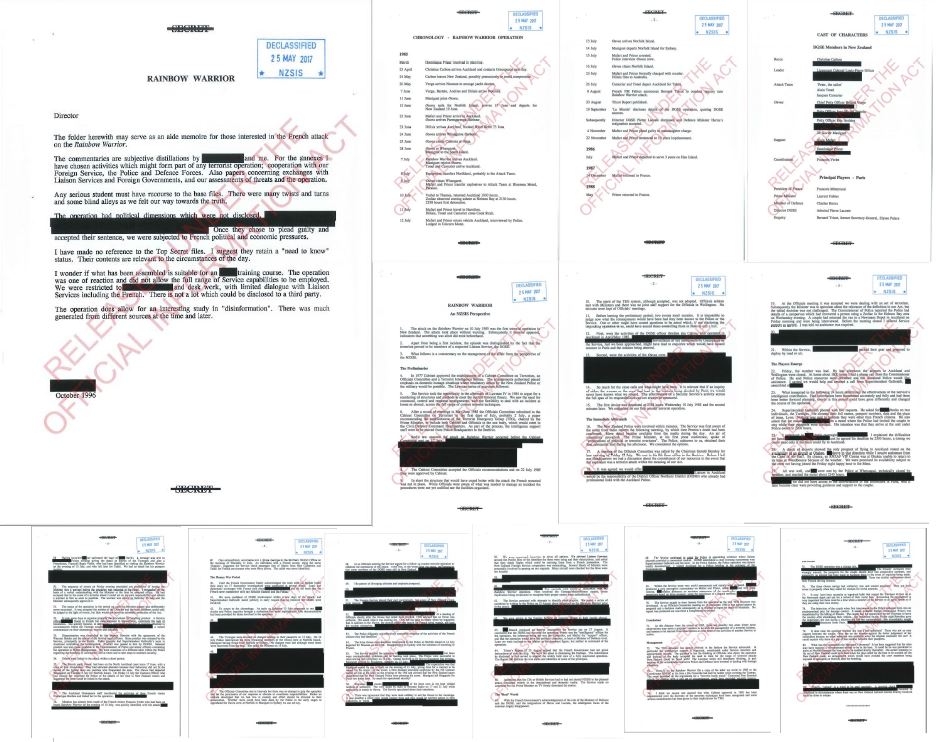
Lange’s private secretary, Chris Beeby, had secretly negotiated with the French.
Brazenly, Palmer claimed during the Q&A session at a 2015 Victoria University panel entitled, “The Rainbow Warrior—a game changer? A 30 year retrospective”, that the dispute was settled in accordance with proper legal principles.
No one guffawed.
In the course of the predictable, protracted ‘negotiations’ between French and New Zealand officials, new bonds were formed. And the GCSB scored a Five Eyes spy base, supposedly because NZ was out of ‘the club’. David Lange fumed. The opera was over.
The Opération Sataniqué bomb mission to sink Greenpeace’s Pacific Ocean flagship, Rainbow Warrior on 10/7 in 1985, worked as a dues ex machina plot device to resolve a narrative impasse, whose tangled lines extended back to the 1970s.
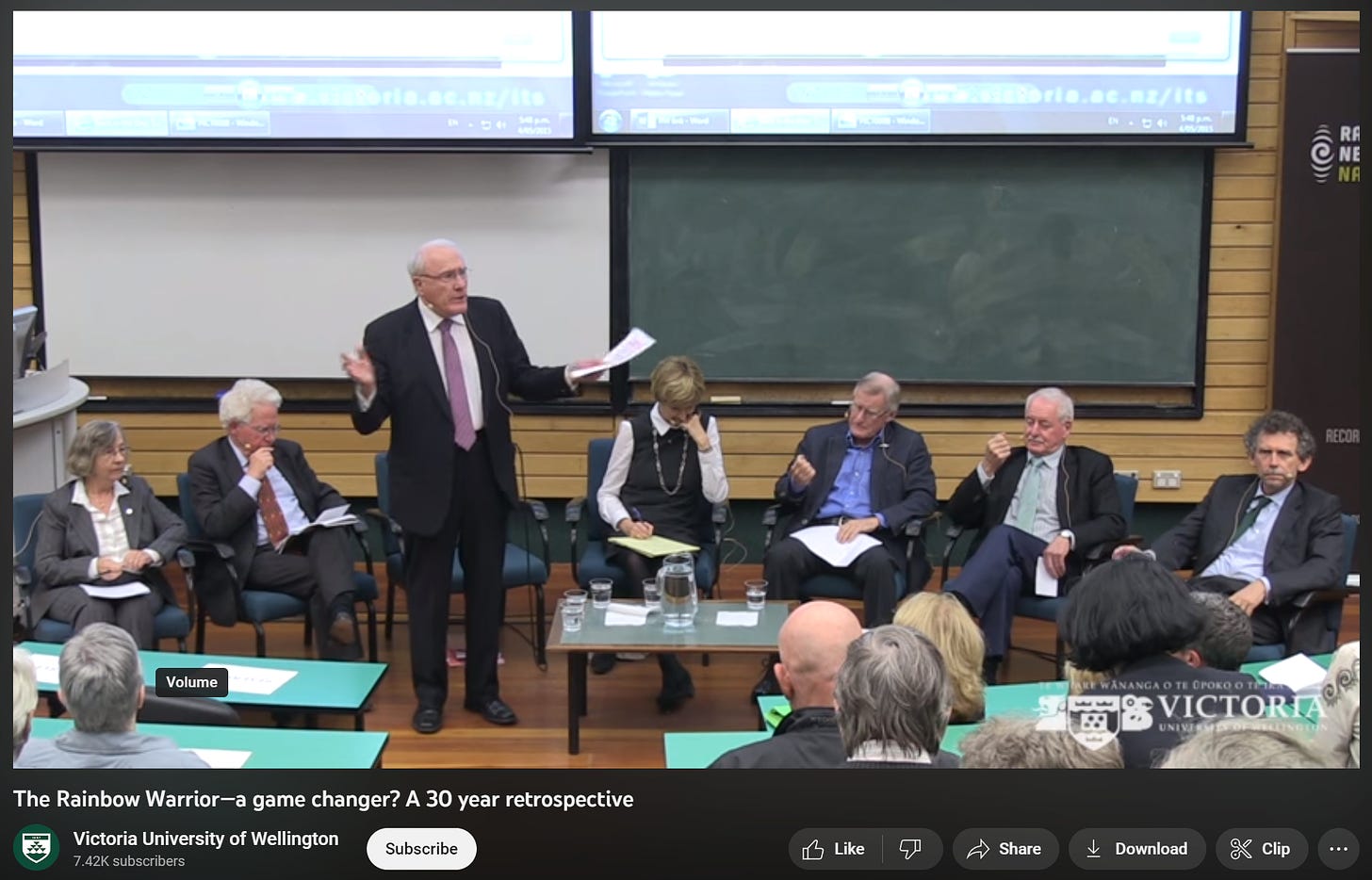
Derived from Greek and Roman theater, a Deus Ex Machina (or god from the machine) is a plot device that unexpectedly resolves a deadlocked conflict, by the sudden appearance of an implausible character, object, event, power, or action.
In 1973, the New Zealand and Australian governments took France to the International Court of Justice to try to stop the Moruroa Atoll tests. However, France refused to follow the court’s ruling. France was a big sovereign. New Zealand’s Prime Minister, Norman Kirk, sent two New Zealand navy frigates to protest on the edge of the Moruroa testing area, which in effect, supported a protest flotilla of civilian yachts protesting, including the Greenpeace yacht, Vega, skippered by David McTaggart.
Australian Prime Minister Paul Keating (1991 to 1996) said that following the Rainbow Warrior attack “the centre of gravity had shifted” and the perceived need for anti-nuclear legislation became inevitable. This ‘centre of gravity’ terminology is the language of geopolitics, which is the struggle for space, resources and power.
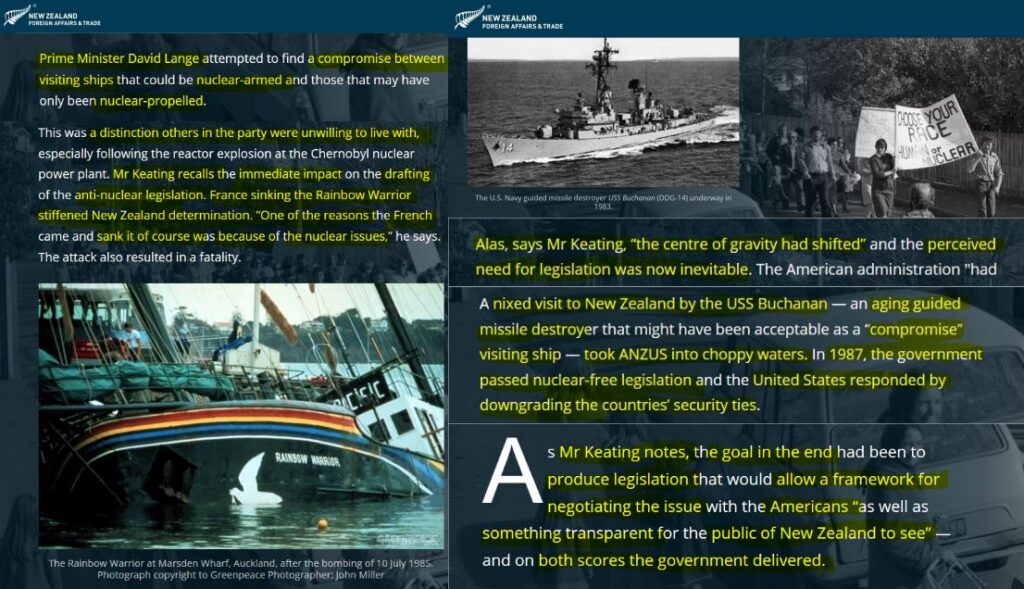
Attitudes about a nuclear-free New Zealand had hardened. The subsequent passage of the New Zealand Nuclear Free Zone, Disarmament, and Arms Control Act in June 1987 saved the Lange Labour Government from losing the 1987 election, amid the economic warfare it inflicted. The Labour Party’s anti-nuclear faction were successfully distracted from the far-reaching economic issues, in the wake of the Warrior Bombing, which supplied them with a cause célèbre, while the news media reported the ‘opera’.
Military exercises between New Zealand and the United States ended until 2010.
Where ‘Operation Gladio’ operated with the modus operandi of false flag attacks to deflect blame to left wing communists and therefore to shift the political ‘center of gravity’ of Western Europe away from socialist governments, by associating peace, freedom and democracy with right wing governments — the intended ‘strategy of tension’ of Opération Sataniqué, appeared to be to cause Greenpeace and the Lange Government to be uncertain about the identity of the perpetrators.
The French Government’s attempt to inflict a price on both Greenpeace and New Zealand backfired badly, because the covert origin of Opération Sataniqué was blown. While the shortened countdown was the primary factor that led to two French DGSE agents being convicted, a closing of ranks occurred — domestically and internationally — to constrain, sabotage and defuse the investigation, prosecution and political fallout.
The date of the attack, 10/7, was potent. A key feature of covert operations is codified symbolism.
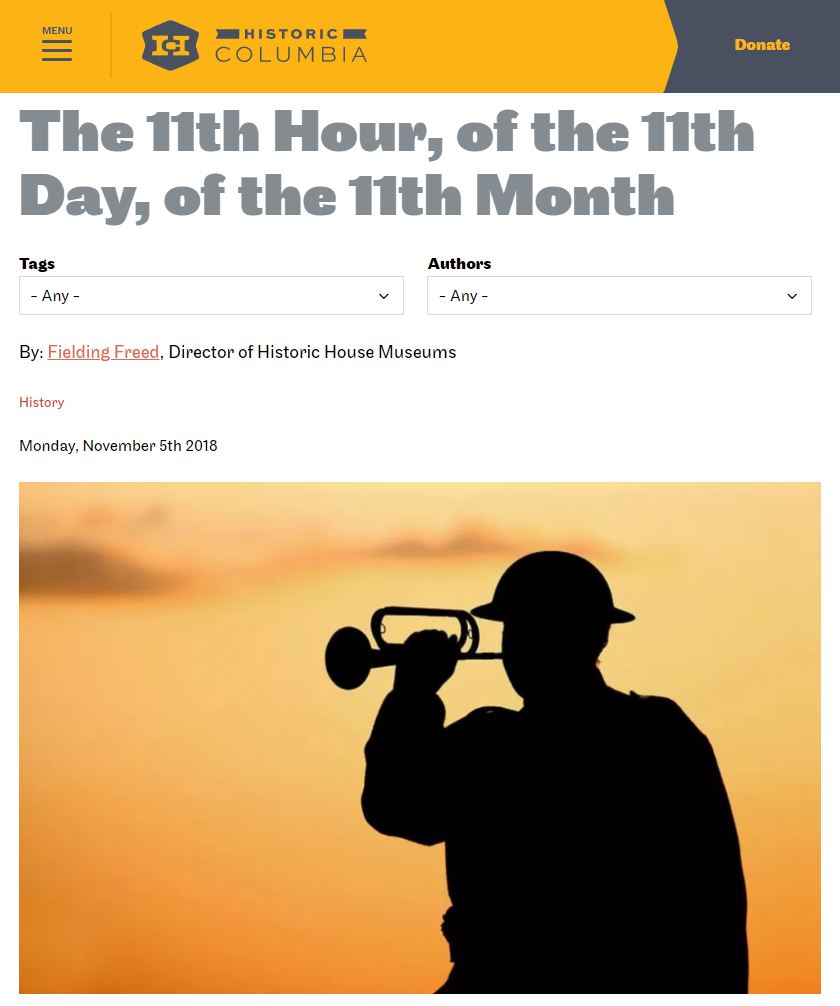
For instance, World War I — which was triggered with a covert operation on June 28, 1914, in the City of Sarajevo — ended with a ritual display of spectacular power by timing the cessation of hostilities to occur at the 11th hour of the 11th day of the 11th month of 1918. Popular history would have it, that the assassination of Archduke Ferdinand and his wife by Bosnian Serb nationalist, Gavrilo Princip, was the reason for the start of World War I. However, no one is that popular.
Encouraged by a Russian military attaché, Colonel Victor Artamanov, the assassination was planned by the Serbian intelligence, who cast six teenage students for what was, in essence, the inciting incident for what was really a two global war-theater play. In an epic conspiracy with brinkmanship, plot twists, and betrayals, Britain’s Oligarchy sought a British-led New World Order, with America as its subordinate partner. And with immense hubris, Britain’s Secret Elite bribed officials, military commanders and royals from numerous countries to foment war — as retold in Gerry Doherty’s and Jim Macgregor’s Hidden History: The Secret Origins of the First World War.
Ironically, the United Nations in effect endorsed terrorism when the Secretary-General, Javier Perez de Cuellar, continued the theater by acting to broker a resolution agreement between France and New Zealand, instead of mounting his own investigation into state-sponsored terrorism. If Mr de Cuellar had done so, whistleblowers might have revealed a transnational intelligence, terrorism and narcotics network — called the Safari Club — was actually the brainchild of the director of the DGSE’s predecessor agency, the SDECE. The Safari Club was founded by two of the Vatican’s Maltese Knights, Count Alexandre de Marenches, the director of the French Service de Documentation Exterieure et de Contre-Espionnage (SDECE) (1970-1981); and the Jesuit-educated U.S. Army General, Vernon Walters. This alliance — formed between the heads of American, Saudi Arabia, and Pakistani intelligence agencies and bound France, Egypt, Iran, Iraq and Pakistan — became a supranational deep state private intelligence network.
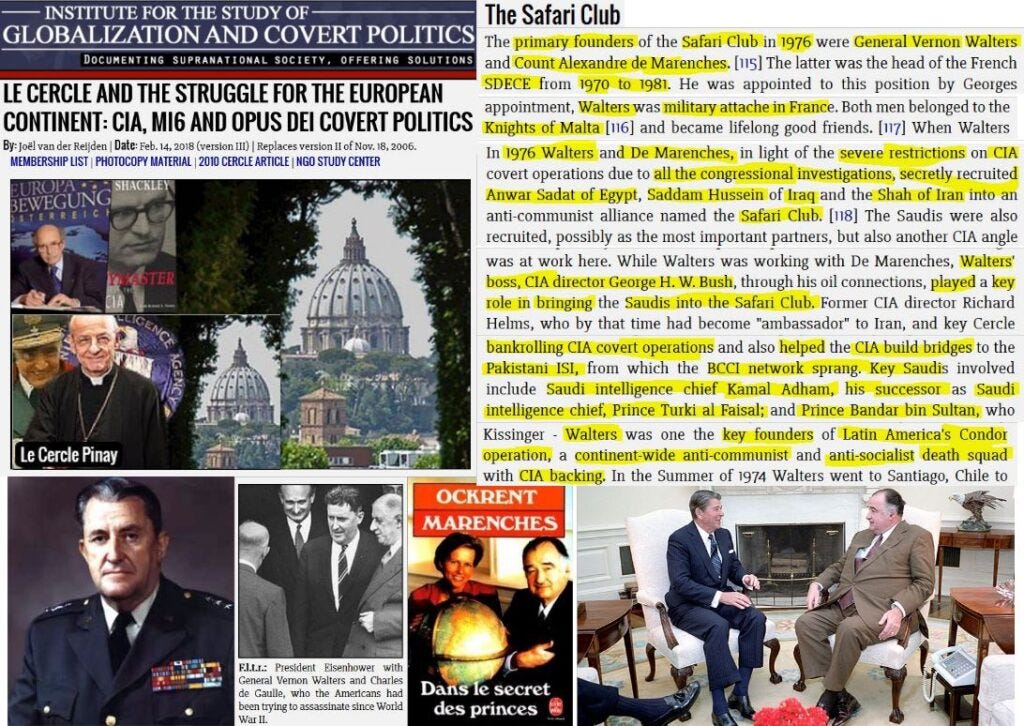
Moreover, it was George Herbert Walker Bush who, as CIA Director (1976-77), was tasked with persuading the Saudi Royal Family to join the Safari Club, and take over a large chunk of covert intelligence financing for the American Deep State. This geopolitical chess move marked the exponential rise of Islamic terrorism, which is deeply ironic given that Bush II was president at the time of the 9/11 Coup D’état.
Especially, since the Al Qaeda terrorist network were entirely blamed for the attacks on the potent date of September 11 in 2001, which corresponds to the emergency phone-call number in the United States: 911.
Particularly, since during the Frank Church Senate Committee probes of 1975-77 into the activities of the FBI, CIA and NSA that underpinned Watergate, COINTELPRO, MK-ULTRA, Project Mockingbird and the JFK Assassination — the machinations of an out-of-control US National Security State became evident to the American people. The credibility of the intelligence, security and criminal investigation agencies ‘suffered‘ from the retrenchment that ensued, to reign in their unbridled, unconstitutional and unconscionable plots, practices and powers. The 9/11 Coup D’état reversed the CIA’s retrenchment of the mid-1970s.
In his excellent book, Another Nineteen: Investigating Legitimate 9/11 Suspects, Kevin Ryan links many of his key suspects to the means to pull off such an epic, brazen exhibition of blockbuster live terror theater. Ryans’ account deftly shows the continuity of ’the Enterprise’ observed on the surface, in the background and the subsequent cover-ups of structural deep events from the JFK Coup D’état, Watergate, the October Surprise, the Iran-Contra Scandal, BCCI, the Oklahoma City Bombing, and the 9/11 Coup D’état. Professor Ganser, the Swiss historian, lectures that the entire official 9/11 account itself collapses under scrutiny.
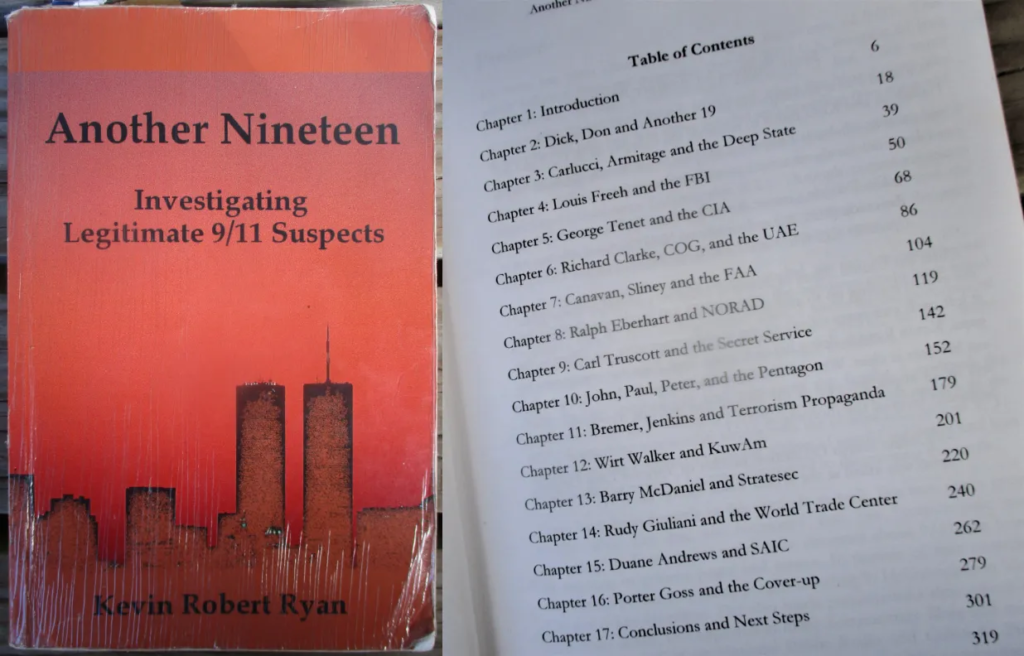
Poignantly, in late February 1985, when the U.S. Deputy Secretary of the National Security Council Admiral John Poindextor met with Gerald Hensley, the admiral emphasized the need for careful risk management. He added President Reagan did not want to go down in history for having ‘lost New Zealand’. In Friendly Fire, Hensley neglected to mention that since Poindexter was chairman of the National Security Council staff, he was also responsible for leading and managing the Crisis Pre-Planning Group from 1983 to 1985.
During the Reagan White House, George H. W. Bush re-arranged the National Security Council committees to by-pass the State Department. Admiral Poindextor was taking direction from the Vice.
After the U.S. Congress passed the 1984 Boland Amendment, a law that cut off U.S. government money for the Contra rebels in Nicaragua, National Security Council staff became part of a secret effort — headed by NSC staffer Lt. Col. Oliver North — to raise funds from other countries and private contributors. According to a Congressional report, that effort eventually developed into ‘the Enterprise’, a private organization that “had its own airplanes, pilots, airfield, operatives, ship, secure communications devices and secret Swiss bank accounts.” Cocaine one-uped opium as a black ops funding source. The Enterprise also became involved in secret deals in 1985 and 1986 in which Israel sold missiles to Iran on behalf of the Reagan Administration in an effort to obtain the release of hostages held in Lebanon. Admiral Poindextor’s conviction over the Iran-Contra Affair was overturned during Bush I’s presidency.
The Enterprise overlapped with the Safari Club, that in turn overlapped with Gladio. Snakes writhed with snakes.
Although Opération Sataniqué was a rushed mission, the twisty layering apparent in its design was also sinister, since the codified metaphors were targeted for its primary audience: spooks.
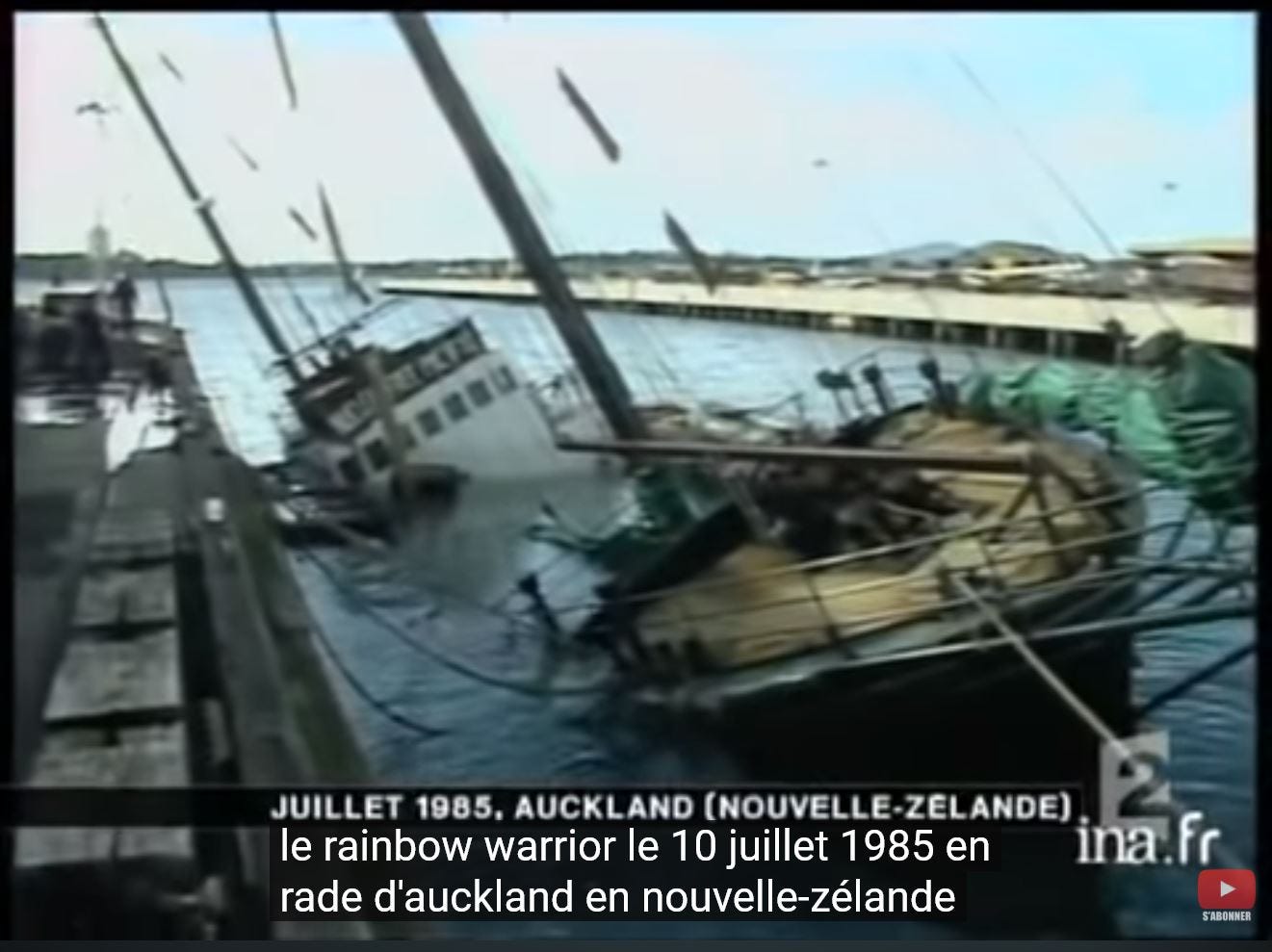
In this metaphor-laden up-side-down ‘Hansel and Gretel’ tale plot, it would appear the wicked purpose of the ‘show me how’ cooking demonstration was to engineer a crisis that would pull New Zealand’s national security state into the ‘club’ on an inside track.
This was, I contend, the hidden Trojan SeaHorse element designed into the bomb plot, to resolve a deadlocked conflict. Amid the set-backs, damage control saved the re-set course, while two DGSE agents were unexpectedly taken ‘out of service’.
As a dues ex machina plot device to resolve a narrative impasse, Opération Sataniqué left ‘calling cards’ to New Zealand’s national security élite to ‘get in touch’. It would seem a Hansel and Gretel ‘show me how’ lesson became a tragic-comic opera with a fuming fat man.

* From the 1970s: Ten–Seven: ‘now engaged in job’. [NZ Police Cadet Training Instructions 1970].
Steve ‘Snoopman’ Edwards is a dissident journalist, who worked at indigenous broadcaster, Māori Television, for 14 years as an editor of news, current affairs and general programs. He graduated with First Class Honours in a Master in Communication Studies at AUT University after writing his ground-breaking thesis on the Global Financial Crisis (GFC), titled — “It’s the financial oligarchy, stupid” — to figure out the means, modus operandi and motives of oligarchs.
Editor’s Note: If we have made any errors, please contact Steve ‘Snoopman’ Edwards with your counter-evidence. e: steveedwards108[at]protonmail.com

